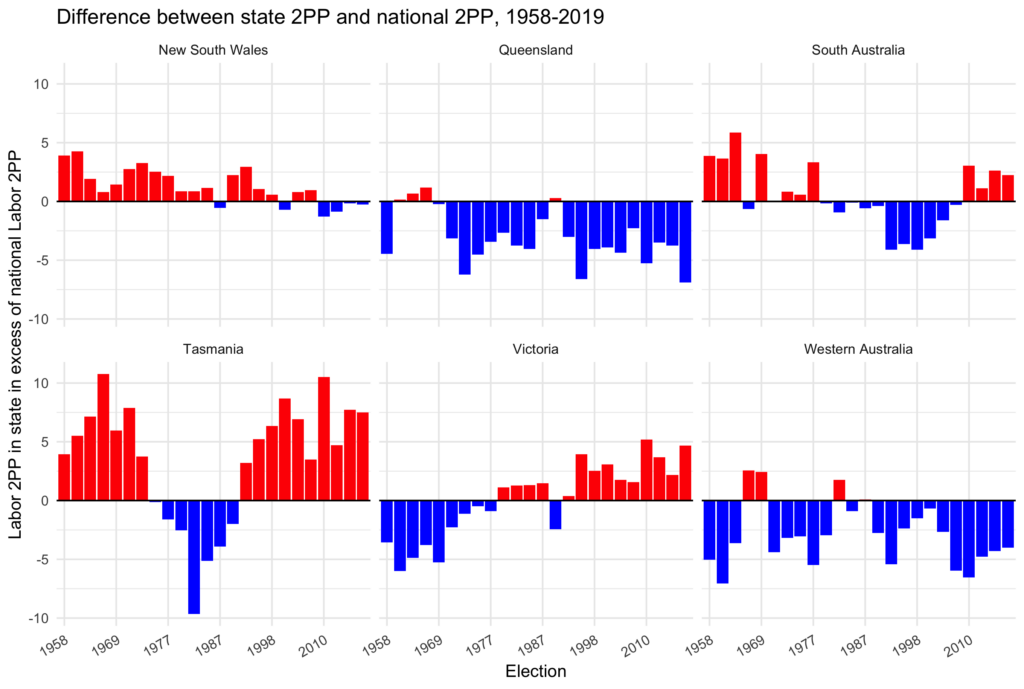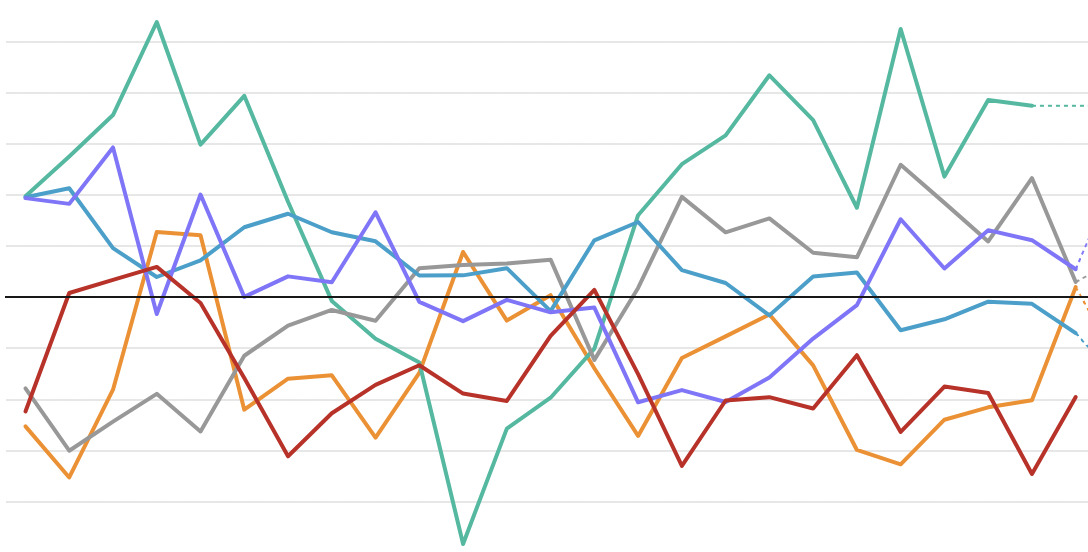One of the big questions at this election is how the result will play out in each state. Labor has performed poorly in Queensland and Western Australia but is hoping to pick up ground there.
For this post I wanted to examine the historic record on how the two-party-preferred vote in each state varied from the country overall. Then I look at what the latest polling suggests could happen in 2022.
I am using a dataset of two-party-preferred figures dating back to 1958. I believe this date was chosen because it was the first election with no uncontested seats, although it’s been a while since I received it. I’m using this data to look at how each state has shifted relative to the country as a whole over that time period, measured by the two-party-preferred metric.
If you just looked at the statewide two-party-preferred vote, it would be buffeted by the back-and-forth swings of national politics, many of which move in similar directions in every jurisdiction. But if you subtract the national two-party-preferred percentage from the state figure, you get a figure which is adjusted for the vote of the remainder of the country to see how much each state leans to one of the major parties.
I’m going to show this data in two ways. This first chart shows each of the six states separately. Thanks to everyone who gave me advice on how to best display this data.

Each chart shows how much that state’s two-party-preferred vote has leaned towards Labor (red) or Coalition (blue) relative to the national two-party-preferred vote.
New South Wales has never had as much of a lean as smaller states, I’m sure in part because it makes up about a third of the country, so it has greater influence over the national two-party-preferred vote. It has shifted to the right since the 1950s, and has had a slight pro-Coalition lean over the last decade.
Victoria has moved in the opposite direction. It leaned 6% to the right in 1961, but had a Labor lean by 1980, and has only leant to the Coalition once since 1980. The pro-Labor lean has been generally increasing, reaching recent peaks when Labor was led by Victorians in 2010 and 2019.
Queensland has generally leant to the right, but that trend has become more severe in recent decades, peaking at a 6.9% lean in 2019. Western Australia has had a similar rightward lean, but without much of a trend towards more right-wing results. The most pro-Coalition result in WA was in 1961, with 2007 and 2010 not far behind.
South Australia and Tasmania both shifted to the right in the middle of the time period we’re examining, before swinging back to the left. Each leaned heavily to the left in the 1960s, and lean to the left now (Tasmania more than South Australia), but Tasmania’s lean to the right peaked in 1983 and South Australia’s lean to the right was strongest from 1993 to 1998.
So what can we expect this time? All of the caveats we apply to national polling should apply moreso to the state breakdowns within, but William Bowe has managed to produce state polling averages for the five most populous states in his BludgerTrack average.
I’ve used the BludgerTrack figures to calculate similar estimates of how each state leans relative to the national polling, and included them in this next chart, which otherwise shows the same data as the previous chart, but gives a better sense of how states move together or apart.
It's mostly pretty crowded, although you can see that no states had strong Labor leans in the 1980s, with both NSW and Victoria leaning slightly to Labor.
Most of the states appear to now be heading closer to the national trend. Recent polls suggest Labor will gain a larger swing in Queensland and Western Australia, and smaller swing in Victoria and South Australia, pushing all four states towards convergence. New South Wales, which slightly leant to the right in 2019, is currently on track for a smaller pro-Labor swing than the country, giving it more of a lean.
Of course we're talking about small percentages in state polling breakdowns, so the final results may look a bit differently. But these state trends can make a huge difference to how the national two-party-preferred vote translates into seats, with Labor particularly hopeful of making gains in Western Australia, often one of their weakest states.




Historic???
I think you mean historical
🙂
Victoria`s strong 2PP results for the Coalition 1955-1972 had the Split in the ALP and resulting DLP preference flow to the Coalition and this likely also tilted the national 2PP to the Coalition, given Victoria`s size. Before the split Victoria was less lopsided.
Remarkable that even Kevin 07 couldn’t erase QLD’s LNP lean.
Comments are closed.